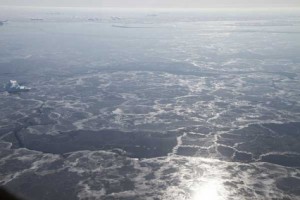Arctic Death Spiral: More Bad News About Sea Ice
 The sea ice that blankets the Arctic Ocean each winter peaked in early March this year, as usual, and is now in retreat, en route to its annual minimum extent in September. How low it will go is something scientists worry: Ice reflects lots of sunlight back into space, and when the darker ocean underneath is exposed, more sunlight is absorbed to add to global warming.
The sea ice that blankets the Arctic Ocean each winter peaked in early March this year, as usual, and is now in retreat, en route to its annual minimum extent in September. How low it will go is something scientists worry: Ice reflects lots of sunlight back into space, and when the darker ocean underneath is exposed, more sunlight is absorbed to add to global warming.That’s the simple version of the story, but things look even worse when you dig into the details. For one thing, all that open water does re-freeze each winter, but it freezes into a relatively thin layer known as seasonal, or first-year ice. Because it’s so thin, first-year ice tends to melt back quickly the following season, giving the ocean a chance to warm things up even more in what National Snow and Ice Data Center director Mark Serreze has called a “death spiral” that could lead to ice-free Arctic summers by 2030.
But it’s worse than that, says a new analysis by scientists at the U.S. Army’s Cold Regions Research Laboratory in Hanover, N.H. “First-year ice is not just thinner, ” said Donald Perovich, lead author of a report in Geophysical Research Letters, in an interview. “We’re also beginning to realize it has other properties.” The most important: New ice is less reflective than old ice, for most of the year, anyway. It absorbs more heat from the Sun, which means it doesn’t just melt faster: It actually speeds up its own melting.
Here’s how it happens, according to Perovich. “Most of the precipitation in the Arctic,” he said, “happens at the end of summer and in the early fall.” When the snow first begins to fall, it builds on the multi-year ice, but disappears onto the patches of open ocean. Those patches eventually freeze, and the snow sticks there as well; it just forms a thinner layer. So for most of the winter, all of the ice, thick and thin, is covered with a brightly reflective blanket. That would be good as far as warming is concerned, except that for most of the winter, the Sun doesn’t rise.
When the Sun finally does rise in spring, it melts the thinner snow first, forming heat-absorbing pools on the surface of the first-year ice. The older ice eventually catches up, forming pools of its own, but since the surface is crumpled, the ponds don’t spread as widely, and they absorb less heat.
In short, the death spiral — where more melting leads to more melting — appears to be even steeper than anyone thought.
That doesn’t mean that there’s less ice literally every year. The lowest levels ever recorded happened in September of 2007; since then, coverage has been bouncing around near, but not quite at, those historic lows, and first-year ice in the winter has been near its historic highs.
“What it means,” Perovich said, “is that with more seasonal ice, the Arctic is more susceptible to an outlier kind of year.” If there’s significantly more heat in a particular year due to natural variations, in other words, there could be a huge loss of ice. It’s kind of like a staircase, Petrovic said. “It bounces around for a while, then there’s a drop to a new normal, then it bounces around.” The point, he said, is that “we now have a type of ice cover that’s even easier to knock over than it was before.”
What that means is that at some point in the not too distant future, an unusually warm summer (even for a globally warming world) could knock the ice in the Arctic ocean down another major step, and take the world closer to the time when all of it vanishes — creating a new heat-trapping region where none existed before, and pushing climate change into an even higher gear.
You can return to the main Market News page, or press the Back button on your browser.

